|
 Secure Site
Secure Site
|
 |
 Meditation is a Quick Fix for Stress Meditating for just 20 minutes a day for five days helped to increase energy and decrease anxiety and stress, as measured by levels of stress hormones, a small study found.
Using the so-called integrative body-mind training method, which comes from traditional Chinese medicine, the study participants reported better attention and control of stress than those relying on relaxation training, which is popular in the West.
Although derived from Chinese medicine, integrative body-mind training uses aspects of other meditation and mindfulness training, the study authors said.
“A meditation method developed in China showed remarkably better performance among those who went through the training compared with those who used relaxation training,” said lead researcher Michael Posner, a psychology professor at the University of Oregon’s Institute of Cognitive and Decision Sciences.
In the study, published in this week’s issue of the Proceedings of the National Academy of Sciences, the researchers assigned 40 undergraduate students from China to either integrative meditation or relaxation therapy.
 Meditation Posner’s group found the students who used integrative meditation for 20 minutes a day for just five days showed greater improvement in conflict scores on a test of stress levels, lower anxiety, depression and anger. Conversely, they displayed more energy, less fatigue, a significant drop in levels of the stress hormone cortisol, and an increase in immunoreactivity, compared with students receiving the relaxation therapy.
Integrative body-mind training was developed in the 1990s, and has been studied in China since 1995. Based on the results from hundreds of adults and children ranging from 4 to 90 years old in China, the practice appears to improve emotional and cognitive performance and social behavior, the study authors said.
Because the study was done in China, Posner said he’s not sure if the same meditation method would work in the United States.
“This is a kind of scientific demonstration about the possible advantage of meditation, at least for the Chinese undergraduates,” Posner said. “It could be culturally specific.”
Posner does think, however, that the study shows it’s possible to change the levels of stress hormones with training.
More information
To learn more about meditation, visit the U.S. National Center for Complementary and Alternative Medicine.
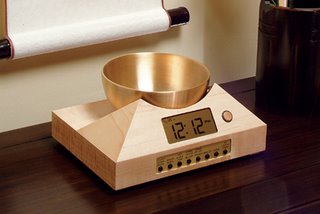 Once you experience the Zen Timepiece's progressive tones, you'll never want to meditate any other way. It serves as the perfect meditation timer. Now & Zen – The Gong Meditation Timer Shop
1638 Pearl Street
Boulder, CO 80302
(800) 779-6383
Posted in Meditation Timers, Meditation Tools, mindfulness practice
 Sleeplessness Finding yourself wide awake after a few hours of sleep, or waking often during the night is called “parasomnia” or “sleep maintenance insomnia,” and it’s much more common than people think. A 2005 National Sleep Foundation poll found that 75 percent of adults frequently have symptoms of sleep dysfunction, including waking during the night.
Just as the victims in slasher flicks make fatal errors (why are you running up the stairs?), we are often our own worst enemies when it comes to a solid night of sleep. “People think that because they’re able to fall asleep they’ll stay asleep, even if they’ve had too much caffeine,” says Rubin Naiman, Ph.D., a sleep and dream specialist at Andrew Weil’s Program in Integrative Medicine at the University of Arizona.
But for most of us, trouble sleeping isn’t usually caused by that espresso at 5 p.m. “The root of most sleep problems is stress,” says Jeffrey Thompson, director of the Center for Neuroacoustic Research and creator of an audio sleeping aid called the Delta Sleep System.
We’re overloaded, over-stimulated, and overwhelming our bodies’ ability to relax. “Our nervous system is built for a sprint, but we’re living in a stress marathon,” he says. “If you go to bed worried you’re probably going to wake up in the middle of the night,” Dr. Naiman adds. And when sleeplessness happens, as you probably know, the next day is pretty much shot.
A new generation of sleep scientists are overturning the conventional wisdom about parasomnia. (Counting sheep? Out.) The doctors say: You can do it. With a few simple changes in your routine, a little visualization, a couple of surprisingly counter-intuitive moves and perhaps an attitude adjustment, a peaceful night of slumber can be yours. Here’s their best advice:
Throw out your definition of a good night’s sleep
Just as three meals a day has given way to all-day grazing and smaller portions, “what’s good for you” has changed here, too.
“Thinking it’s necessary to stay asleep for 8 hours straight may be unrealistic,” says David Neubauer, M.D., associate director of the Johns Hopkins Sleep Disorders Center and author of Understanding Sleeplessness: Perspectives on Insomnia. “Just as we experience a dip in alertness mid-afternoon, the inverse is a dip in sleepiness in the middle of the night. There’s strong evidence that there’s a kind of awakening that’s totally normal.” History supports this take, Dr. Naiman says. “Before the industrial revolution, people had their first sleep for 3 to 4 hours, awoke for an hour or two, then slept for another 3 or 4 hours.”
Even waking every 60 to 90 minutes can be part of a healthy sleep pattern. The deeper stages of sleep, or REM (rapid eye movement) sleep, occur about every 90 minutes and get longer as the night goes on, so your brain might become more alert between those cycles.
 Sleeplessness Since we’re conditioned to think that waking during the night is a problem, when it happens, we panic. That reaction causes our brains to awaken even further, Dr. Neubauer explains.
If you find yourself awake in pre-dawn hours, Dr. Naiman advises first assessing your physical state. Do you have an ache, a cramp, or need to go to the bathroom? If so, take care of it.
If you don’t have a physical complaint, then chances are you are experiencing a normal stage of the sleep cycle. Knowing this “helps replace worries that you’ll be useless without 8 solid hours of sleep with more neutral thoughts,” suggests Sat Bir Khalsa, Ph.D., instructor in medicine at Brigham and Women’s Hospital at Harvard Medical School. “The useful thought is: ‘I can handle the disruption and still feel rested.'”
Get bed-ready
After an action-packed day (or one equally packed with worry), our brains need some time to catch up, to make order of things, and to slow their frenetic firing before we’re ready to sleep. Pure bodily exhaustion can probably get you at least that first hour of dozing, but then worries will rise to the surface and cause you to stir. How can you get your mind to chill?
“We need to learn to apply the brakes before the car is in the garage,” Dr. Naiman says. “Clearing your head is key to a good night of sleep.” Simply taking 15 minutes to sit quietly, meditate, pray, or do rhythmic breathing can allow your mind to slow down enough to sleep through the night.
Establishing any ritual that you do before bed—anything but checking your e-mail!—will do more than relax you right then and there. The repetition also conditions your brain and body for sleep, Thompson explains.
While you’re transitioning to Z-mode the same way night after night, you’re also creating a Pavlovian response to your ritual. So simply sitting in the spot where you do your breathing or turning on the shower water signals your mind that it will be sleeping soon, Thompson says.
Another way to condition yourself sleepward is by playing off the body’s internal clock. Dr. Naiman suggests simulating dusk about an hour before you plan to go to bed and dimming the lights significantly. This triggers natural circadian rhythms that help us prepare for sleep.
adapted from Women’s Health Magazine, by BY LIESA GOINS
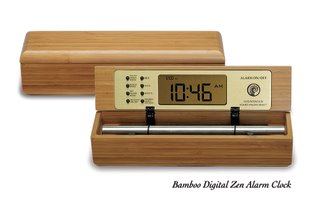 Wake up refreshed, love your alarm clock, transform your mornings with The Zen Alarm Clock's progressive awakening with gentle chimes.
Now & Zen – The Chime Alarm Clock Shop
1638 Pearl Street
Boulder, CO 80302
(800) 779-6383
Posted in Bamboo Chime Clocks
 Yawning May Cool the Brain Study also found sinuses act like a bellows, help keep brain the right temperature
Yawning helps keep the brain cool, and the sinuses play a role in that process by acting as bellows, a new report suggests.
Yawning isn’t triggered because you’re bored, tired or need oxygen. Rather, yawning helps regulate the brain’s temperature, according to Gary Hack, of the University of Maryland School of Dentistry, and Andrew Gallup, of Princeton University.
“The brain is exquisitely sensitive to temperature changes and therefore must be protected from overheating,” they said in a University of Maryland news release. “Brains, like computers, operate best when they are cool.”
During yawning, the walls of the maxillary sinuses (located in the cheeks on each side of the nose) flex like bellows and help with brain cooling, according to the researchers.
They noted that the actual function of sinuses is still the subject of debate, and this theory may help clarify their purpose.
“Very little is understood about them, and little is agreed upon even by those who investigate them. Some scientists believe that they have no function at all,” Hack said in the news release.
The researchers said their theory that yawning helps cool the brain has medical implications. For example, excessive yawning often precedes seizures in people with epilepsy and pain in people with migraine headaches.
Doctors may be able to use excessive yawning as a way to identify patients with conditions that affect temperature regulation.
 Yawning May Cool the Brain “Excessive yawning appears to be symptomatic of conditions that increase brain and/or core temperature, such as central nervous system damage and sleep deprivation,” Gallup said in the news release.
The paper appears in the December issue of the journal Medical Hypotheses.
More information
The American Rhinologic Society has more about sinuses.
— Robert Preidt
SOURCE: University of Maryland at Baltimore, news release, Nov. 14, 2011
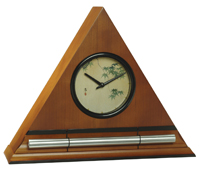 The Zen Alarm Clock transforms mornings, awakening you gradually with a series of gentle acoustic chimes Once you use a Zen Clock nothing else will do Now & Zen – The Chime Alarm Clock Shop
1638 Pearl Street
Boulder, CO 80302
(800) 779-6383
Posted in sleep
 trouble sleeping? By John D. Sutter, CNN
There’s growing concern that the glowing screens of laptops and the iPad may affect sleep if used right before bedtime.
J.D. Moyer decided recently to conduct a little experiment with artificial light and his sleep cycle.
The sleep-deprived Oakland, California, resident had read that strong light — whether it’s beaming down from the sun or up from the screens of personal electronics — can reset a person’s internal sleep clock.
So, for one month, whenever the sun set, he turned off all the gadgets and lights in his house — from the bulb hidden in his refrigerator to his laptop computer.
It worked. Instead of falling asleep at midnight, Moyer’s head was hitting the pillow as early as 9 p.m. He felt so well-rested during the test, he said, that friends remarked on his unexpected morning perkiness.
“I had the experience, a number of times, just feeling kind of unreasonably happy for no reason. And it was the sleep,” he said. “Sure, you can get by with six or seven hours, but sleeping eight or nine hours — it’s a different state of mind.”
Moyer may be onto something.
More than ever, consumer electronics — particularly laptops, smartphones and Apple’s new iPad — are shining bright light into our eyes until just moments before we doze off.
Now there’s growing concern that these glowing gadgets may actually fool our brains into thinking it’s daytime. Exposure can disturb sleep patterns and exacerbate insomnia, some sleep researchers said in interviews.
“Potentially, yes, if you’re using [the iPad or a laptop] close to bedtime … that light can be sufficiently stimulating to the brain to make it more awake and delay your ability to sleep,” said Phyllis Zee, a neuroscience professor at Northwestern University and director of the school’s Center for Sleep & Circadian Biology.
“And I think more importantly, it could also be sufficient to affect your circadian rhythm. This is the clock in your brain that determines when you sleep and when you wake up.”
Such concerns are not entirely new: One sleep researcher said Thomas Edison created these problems when he invented the light bulb.
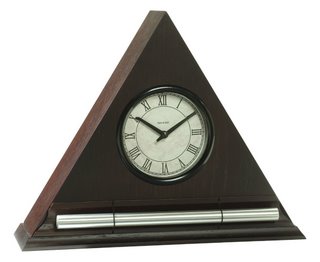 Zen Alarm Clocks Choosing an alternative to your i Pad alarm clock just may help to sleep better.
“The Zen Alarm Clock,” uses soothing acoustic chimes that awaken users gently and gradually, making waking up a real pleasure. Rather than an artificial recorded sound played through a speaker, the Zen Clock features an alloy chime bar similar to a wind chime. When the clock’s alarm is triggered, its chime produces a long-resonating, beautiful acoustic tone reminiscent of a temple gong. Then, as the ring tone gradually fades away, the clock remains silent until it automatically strikes again three minutes later. The frequency of the chime strikes gradually increase over ten-minutes, eventually striking every five seconds, so they are guaranteed to wake up even the heaviest sleeper. This gentle, ten-minute “progressive awakening” leaves users feeling less groggy, and even helps with dream recall.
In the morning, its exquisite sounds summon your consciousness into awakening with a series of subtle gongs that provide an elegant beginning to your day. Once you experience the Zen Timepiece’s progressive awakening, you’ll never want to wake up any other way.
 Zen Alarm Clock Shop - Boulder, Colorado Now & Zen’s Clock Store
1638 Pearl Street
Boulder, CO 80302
(800) 779-6383
Posted in Natural Awakening, Now & Zen Alarm Clocks, sleep, Sleep Habits
 Meditation - A Wellness Practice It’s nearly impossible to pay attention to one thing for a long time. A new study looks at whether Buddhist meditation can improve a person’s ability to be attentive and finds that meditation training helps people do better at focusing for a long time on a task that requires them to distinguish small differences between things they see.
The research was inspired by work on Buddhist monks, who spend years training in meditation. “You wonder if the mental skills, the calmness, the peace that they express, if those things are a result of their very intensive training or if they were just very special people to begin with,” says Katherine MacLean, who worked on the study as a graduate student at the University of California – Davis. Her co-advisor, Clifford Saron, did some research with monks decades ago and wanted to study meditation by putting volunteers through intensive training and seeing how it changes their mental abilities.
About 140 people applied to participate; they heard about it via word of mouth and advertisements in Buddhist-themed magazines. Sixty were selected for the study. A group of thirty people went on a meditation retreat while the second group waited their turn; that meant the second group served as a control for the first group. All of the participants had been on at least three five-to-ten day meditation retreats before, so they weren’t new to the practice. They studied meditation for three months at a retreat in Colorado with B. Alan Wallace, one of the study’s co-authors and a meditation teacher and Buddhist scholar.
 Meditation for Wellness The people took part in several experiments; results from one are published in Psychological Science, a journal of the Association for Psychological Science. At three points during the retreat, each participant took a test on a computer to measure how well they could make fine visual distinctions and sustain visual attention. They watched a screen intently as lines flashed on it; most were of the same length, but every now and then a shorter one would appear, and the volunteer had to click the mouse in response.
Participants got better at discriminating the short lines as the training went on. This improvement in perception made it easier to sustain attention, so they also improved their task performance over a long period of time. This improvement persisted five months after the retreat, particularly for people who continued to meditate every day.
The task lasted 30 minutes and was very demanding. “Because this task is so boring and yet is also very neutral, it’s kind of a perfect index of meditation training,” says MacLean. “People may think meditation is something that makes you feel good and going on a meditation retreat is like going on vacation, and you get to be at peace with yourself. That’s what people think until they try it. Then you realize how challenging it is to just sit and observe something without being distracted.”
This experiment is one of many that were done by Saron, MacLean and a team of nearly 30 researchers with the same group of participants. It’s the most comprehensive study of intensive meditation to date, using methods drawn from fields as diverse as molecular biology, neuroscience, and anthropology. Future analyses of these same volunteers will look at other mental abilities, such as how well people can regulate their emotions and their general well-being.
By Keri Chiodo, Association for Psychological Science
Now & Zen – The Gong Meditation Timer Shop
1638 Pearl Street
Boulder, CO 80302
(800) 779-6383
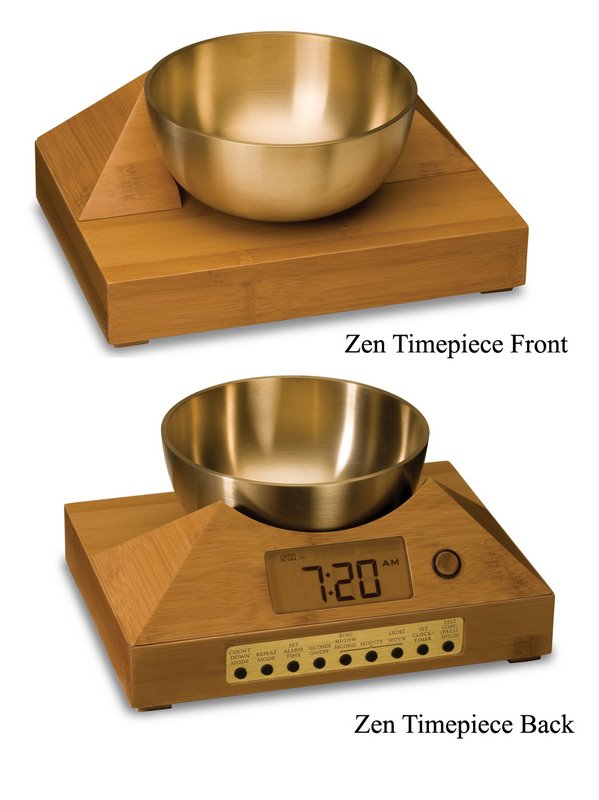 Gong Meditation Timer for Your Wellness Practice
Posted in Meditation Tools
 Exercise May Sharpen Your Brain Even if you start late in life, physical activity can help preserve mental ability, study finds
Older adults who keep active may be helping to reduce their odds of losing their mental abilities, two new studies suggest.
Both reports were published online July 19 in the Archives of Internal Medicine, to coincide with presentations scheduled to be presented Tuesday at the International Conference on Alzheimer’s Disease in Paris.
“We looked at an objective measure of physical activity — most previous studies looked at self-reported levels of physical activity, which always has some inherent error,” said the lead researcher of the first study, Laura E. Middleton, from the Heart and Stroke Foundation Center for Stroke Recovery at the Sunnybrook Research Institute in Toronto.
Using this measure, the researchers found that those who were the most physically active had a 90 percent lower risk of developing significant cognitive decline, compared with those who had the least physical activity, she said.
“This suggests, because this method is able to capture all types of physical activity, that low-intensity physical activity may be important,” Middleton said. “So not just jogging, swimming or biking, but maybe just moving around the house, doing chores, walking outside, may also be important for protection against cognitive impairment.”
 Exercise May Sharpen Your Brain “We shouldn’t just be encouraging people to exercise, we should discourage them from being sedentary,” she added.
For the study, Middleton’s team collected data on 197 men and women who took part in the ongoing Health, Aging and Body Composition study. The participants had an average age of 74 when they started the study and none had any cognitive difficulties, the researchers noted.
To determine the effects of activity on mental ability, the researchers measured the total amount of energy the participants used. To do this, they used a method called “doubly labeled water,” which shows how much water a person loses, which is an objective measure of a persons metabolic activity.
Over two to five years of follow-up, Middleton’s group found that those with the highest levels of physical activity had the lowest odds of developing any cognitive impairment, compared with those who had the least amount of physical activity.
These findings were confirmed by having participants take the Modified Mini-Mental State Examination. The researchers also took factors such as Modified Mini-Mental State Examination scores at the start of the study, demographic factors, body mass, sleep, self-reported health and diabetes.
Middleton noted that while these findings cannot be said to be causal, but it “is an association between physical activity and cognitive change.”
In the second study, a team led by Marie-Noel Vercambre, from the Foundation of Public Health, Mutuelle Generale de l’Education Nationale in Paris, looked at the effect of physical activity among women who were part of the Women’s Antioxidant Cardiovascular Study, which included women with vascular disease or three or more risk factors for heart disease.
Vercambre’s group determined the level of physical activity among 2,809 women at the start of the study and every two years thereafter. In addition they conducted phone interviews with the women that included tests of mental ability and memory. These tests were given at the start of the study and three or more times over the next 5.4 years.
 Expert yoga pose The researchers found that women who were most physically active had the lowest rate of developing cognitive decline. In addition, women who took a brisk 30-minute walk every day, or its equivalent, had the lower risk of cognitive impairment.
Dr. Eric B. Larson, from the Group Health Research Institute in Seattle and author of an accompanying journal editorial, commented that the association between physical activity and mental ability probably had to do with overall vascular health.
“As we get older, our brains are probable less able to withstand stress,” he said. But exercise improves vascular health, he added.
Larson thinks the benefits of exercise on mental ability can accrue even if one starts exercising later in life. “There may be even more benefit, because your state is more risky,” he said. “Just keeping up walking for an older person is a huge benefit.”
Even after dementia has started, exercise can be a benefit, Larson said. “Walking once, twice or four times a week with a caregiver leads to a better outcome and a happier person,” he said.
More information
For more on dementia, visit the U.S. National Library of Medicine.
SOURCES: Laura E. Middleton, Ph.D., Heart and Stroke Foundation Center for Stroke Recovery, Sunnybrook Research Institute, Toronto; Eric B. Larson, M.D., M.P.H., Group Health Research Institute, Seattle; July 19, 2011, Archives of Internal Medicine, online
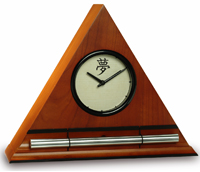 Calming Chime Alarm Clock for a Gentle Awakening Now & Zen – The Chime Alarm Clock Shop
1638 Pearl Street
Boulder, CO 80302
(800) 779-6383
Posted in mindfulness practice
 Feel the Joy: Utamaro Kitagawa, The Courtesan Hanaogi of Ogiya You don’t have to work for happiness. It’s already here to be experienced in every moment.
Janet began her long-planned kitchen remodel filled with dread, certain it would be a difficult experience. A self-described “aversive type,” she knew that her often uncompromisingly high standards, coupled with a tendency to dwell on all the things that might go wrong, were likely to make the project a source of frustration and tension. Janet decided that instead of her usual cycle of anger and impatience, she wanted to have a more positive, joyful experience with the remodel.
Getting clear on her intention to feel joy helped her realize that the attitude she had toward the project would determine not only how she would feel about its outcome but also how rewarding the process would be. She realized that making friends with the workers on the job would be a major step in supporting her positive outlook. “I grew to really care about the people doing the work and looked forward to seeing them each day, learning to trust their judgments and taste,” she said.
She also reasoned that if she could feel satisfaction about the work as it progressed, then that same satisfaction would be there in the completed kitchen. She made a point to look each day for different ways the project gave her a chance to feel pleased. And her theory proved to be true. The pleasure she took in the details of the completed kitchen went deeper than pleasure at the cosmetic and structural improvements.
“When I look at that space, when I get a glass of water or cook a meal, I feel so happy. The whole house feels happier to me and more precious,” Janet reflects. To her surprise, the remodel became a joyful experience from beginning to end.
How do you turn a dreaded kitchen remodel, or any other potentially difficult circumstance, into a nourishing experience and a source of happiness? By changing the default setting of your mind and heart toward greater well-being and feelings of joy.
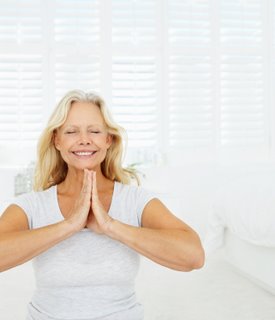 Feel the Joy You do not have to create joy; it is an innate quality already within you, like the capacity to walk or to be kind. You come into this world as an innocent baby with a natural joy. You can still squeal with delight, given the right circumstances. What you likely forget, though, is that you can feel this joy even when the circumstances aren’t just right. In fact, this natural joy is available at all times, and you can consciously cultivate it so that it’s easily accessible, even during difficult moments.
Joy comes in many flavors. For some, it’s an energetic radiance; for others, it’s a quiet feeling of connection. We all have our own way of expressing joy that comes with our unique temperament. In fact, the word “joy” may be a stretch for people who long simply to not be miserable! Those who find “joy” awkward might prefer another word, like “contentment,” “delight,” “happiness,” or “aliveness.” When I use the word “joy,” I often think of it simply as a feeling of well-being.
Truly happy people are not happy all the time. The 10,000 joys and 10,000 sorrows, to use the Taoist phrase, are part of the full tapestry of life. Being joyful does not mean you stop feeling the full range of human emotion. Life is often hard. You get disappointed. A loved one becomes ill or dies. You feel stress in your relationships, finances, or crowded schedule.
Awakening your joy does not mean denying any of these things. Rather, those who discover the secret of well-being are capable and centered and able to be authentically engaged with whatever circumstances life presents. Although you feel the full spectrum of emotions, you know that anger, sadness, and fear are only temporary visitors. With practice, a feeling of well-being can become the baseline that you return to, rather than an occasional surprise. How do you begin this process? The important first step, as Janet discovered, is to set a clear intention to foster greater well-being in your life.
Put Happiness First
We all want to be happy, but many of us don’t put this desire at the center of our lives. We think that if we are successful, rich, or well liked, happiness will follow. But to awaken our natural joy, it’s essential that we consciously prioritize our intention to be happy. For instance, once Janet decided she wanted her project to be a source of joy rather than frustration and anxiety, she was more motivated to find strategies that would support that central intention. In getting clear on your intention for happiness, you access the place inside that truly wants you to be happy.
The next key step is understanding where real happiness lies. In order to experience genuine well-being, the Buddha encouraged developing what he called wholesome, or healthy, states of mind. These states, such as kindness or generosity, have an expansive quality; they open your heart and create more ease in your mind. They are different from unwholesome states, which fan your desires and provide fleeting pleasure but actually contract the mind and lead to suffering. Taking an honest look at what states contribute to an inner ease and expansiveness, and then cultivating them, is an important part of the process.
The Buddha points out that accompanying these healthy states is a natural feeling of gladness. For example, in the middle of a random act of kindness, you can notice this gladness. By bringing mindful attention to the sensations generated in the body and mind, you strengthen this “gladness connected with what is wholesome,” as the Buddha describes it. More than just “feeling good,” you learn to recognize what it feels like to feel good. By becoming more aware of the landscape of well-being, you amplify your joy.
For example, one practice the Buddha recommends to develop well-being is simplicity, or what I refer to as “the joy of letting go.” This is particularly relevant if you tend to fill up your life by taking on more than you can possibly handle. Simplicity can mean bringing more balance to an overcrowded, busy life. To use simplicity as a joy practice, consciously choose to say no to the next delicious invitation, or decide not to add one more “important” task to your schedule. Then notice how good it feels in your body and mind to give yourself the space that opens with that de-cluttering.
 Feel the Joy With some practice, you can not only feel happy in the moment but you can also develop that joy as a habitual response. In one discourse, the Buddha simply and profoundly explains how habits are created: “Whatever the practitioner frequently thinks and ponders upon, that will become the inclination of his mind.” You are making either skillful grooves or unpleasant ruts with repetitive habits of thought. Modern neuroscience has corroborated this: Through repetition you strengthen positive neural pathways in the brain. By frequently inclining the mind toward thoughts associated with greater well-being, you begin to shift your habitual thinking. And the shift becomes deeper still when you act on those thoughts and impulses. As you practice being present for moments of joy as they occur and nourish your spirit in healthful ways, you create the conditions for well-being to arise naturally.
As Janet found, “Even in difficult and challenging moments, there is a deep vein of joy underneath that can be mined. This joy is found whenever I can be present with exactly what is. I’ve never experienced this as joy before, but now I do. I have learned to notice the deep joy I experience in simply being alive.”
Use our unique “Zen Clock” which functions as a Chime Yoga Timer. It features a long-resonating acoustic chime that brings your meditation or yoga session to a gradual close, preserving the environment of stillness while also acting as an effective time signal. Our Yoga Timer & Clock can be programmed to chime at the end of the meditation or yoga session or periodically throughout the session as a kind of sonic yantra. The beauty and functionality of the Zen Clock/Timer makes it a meditation tool that can actually help you “make time” for meditation in your life. Bring yourself back to balance.
Adapted from YogaJourna.com by James Baraz, a founding teacher at Spirit Rock Meditation Center, leads an online course, Awakening Joy, and has co-written the book, Awakening Joy.
Now & Zen – The Chime Meditation Timer and Alarm Clock Shop
1638 Pearl Street
Boulder, CO 80302
(800) 779-6383
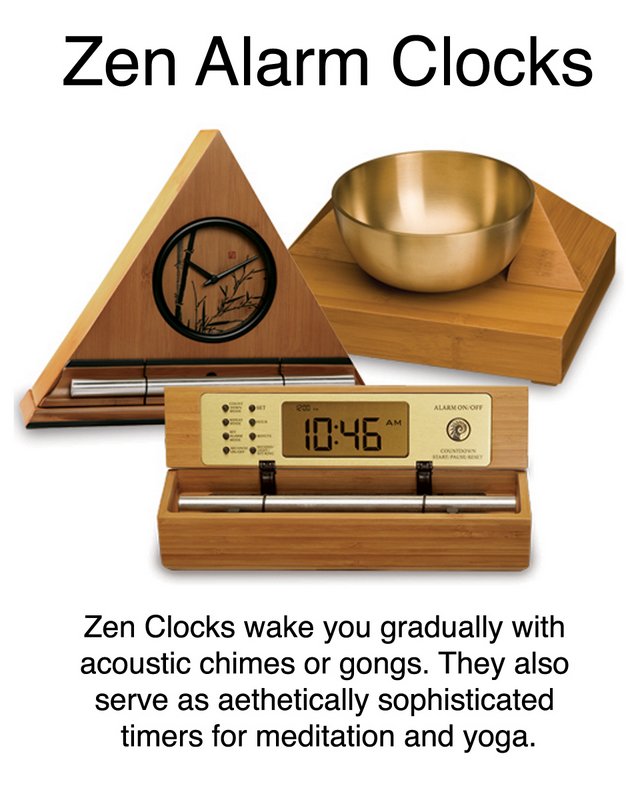 Chime Meditation and Yoga Timers and Alarm Clocks
Posted in Bamboo Chime Clocks
 Sanmonji, sleeping cat Perfect alarm clock gift makes waking up a calming and relaxing experience
Replace Your Loved Ones Alarm Clock, so that you don’t have to be awakened by their Frightening, Beeping Alarm Clock…
Are you tired of your husbands alarm clock?
What makes this gentle awakening experience so exquisite is the sound of the natural acoustic chime, which has been tuned to produce the same tones as the tuning forks used by musical therapists. According to the product’s inventor, Steve McIntosh, “once you experience this way of being gradually awakened with beautiful acoustic tones, no other alarm clock will ever do.”
Boulder, Colorado—an innovative company has taken one of life’s most unpleasant experiences (being startled awake by your alarm clock early Monday morning), and transformed it into something to actually look forward to. “The Zen Alarm Clock,” uses soothing acoustic chimes that awaken users gently and gradually, making waking up a real pleasure. Rather than an artificial recorded sound played through a speaker, the Zen Clock features an alloy chime bar similar to a wind chime. When the clock’s alarm is triggered, its chime produces a long-resonating, beautiful acoustic tone reminiscent of a temple gong. Then, as the ring tone gradually fades away, the clock remains silent until it automatically strikes again three minutes later. The frequency of the chime strikes gradually increase over ten-minutes, eventually striking every five seconds, so they are guaranteed to wake up even the heaviest sleeper. This gentle, ten-minute “progressive awakening” leaves users feeling less groggy, and even helps with dream recall.
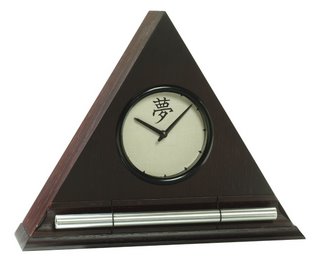 zen alarm clocks for a peaceful awakening Now & Zen’s Clock Store
1638 Pearl Street
Boulder, CO 80302
(800) 779-6383
Posted in Bamboo Chime Clocks, Now & Zen Alarm Clocks, Progressive Awakening, sleep, Sleep Habits, Well-being
 getting enough shut-eye? Children and Sleep: Is Your Child Getting Enough Shut-Eye?
How to tell if your child is not getting enough sleep
For many active school-aged children, sleep can be as hard to come by as it is for busy adults. After-school activities, homework, and playtime with family and friends can all lead to a packed schedule. Add to that the lure of electronics such as TV, computers and videogames, and you have the makings of chronic sleep deficit in kids.
Since school-aged children need between 10 to 11 hours of sleep, parents must be vigilant about enforcing bedtimes, setting up good sleep routines, and watching for signs of fatigue in their children. It’s especially important for school-aged kids to get enough rest. For one thing, one of the factors that can reduce one’s immune system’s ability to fight off infections is not getting enough sleep, and as we know, kids in school are constantly exposed to transmittable illnesses such as colds from classmates. Lack of sleep in children has also been associated with health problems ranging from obesity to mood swings, as well as cognitive problems that can have an impact on a child’s ability to concentrate, pay attention, and learn in school.
Signs of Sleep Deprivation in Children
If you think your child might not be getting enough sleep, look for these signs that she is not getting the amount of sleep she needs. Your child is sleep deprived if she:
- Has trouble waking up in the morning
- Exhibits irritable behavior
- Seems overly emotional and moody
- Is hyperactive
- Has difficulty concentrating in school
- Has trouble staying awake during the day
If you see signs of sleep deficit in your child, try setting up some good nighttime sleep routines and healthy sleep habits to help your child get the amount of rest she needs to be at her best both at home and at school.
Remember that waking up in the morning should be as pleasant as falling asleep at night. The Zen Alarm Clock’s gradual, gentle awakening is transformative.
The Zen Clock’s long-resonating Tibetan bell-like chime makes waking up a beautiful experience – its progressive chimes begin your day with grace.
When the clock’s alarm is triggered, the acoustic chime bar is struck just once … 3-1/2 minutes later it strikes again … chime strikes become more frequent over 10 minutes … eventually striking every 5 seconds until shut off. As they become more frequent, the gentle chimes will always wake you up – your body really doesn’t need to be awakened harshly, with a Zen Clock you’re awakened more gradually and thus more naturally.
Waking up in the morning should be as pleasant as falling asleep at night. The Zen Alarm Clock’s gradual, gentle awakening is transformative.
Waking up in the morning should be as pleasant as falling asleep at night. The Zen Alarm Clock’s gradual, gentle awakening is transformative.
By Katherine Lee, About.com Guide
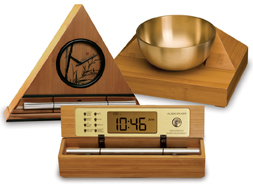 Enhance your sleep rituals by getting the most soothing alarm clock Now & Zen’s Headquarter Clock Shop
1638 Pearl Street
Boulder, CO 80302
(800) 779-6383
 The Zen Alarm Clock Store in Boulder, CO
Posted in Bamboo Chime Clocks, Natural Awakening, sleep, Sleep Habits
 wake up and do something How to Fight the Urge to Sleep Too Much
Not getting enough sleep can sometimes be a bad thing. But did you know that getting too much sleep is just as bad?
One Solution: Wake up and do something. Once you’ve done your routine, get moving. Walk to work, or if you drive, park a bit out and take the stairs up. On the weekend, you can go for a walk or vacuum. Whatever you do, get your blood moving. It’ll let you clear mental cobwebs left by sleep and settle into wakefulness.
Boulder, Colorado—an innovative company has taken one of life’s most unpleasant experiences (being startled awake by your alarm clock early Monday morning), and transformed it into something to actually look forward to. “The Zen Alarm Clock,” uses soothing acoustic chimes that awaken users gently and gradually, making waking up a real pleasure. Rather than an artificial recorded sound played through a speaker, the Zen Clock features an alloy chime bar similar to a wind chime. When the clock’s alarm is triggered, its chime produces a long-resonating, beautiful acoustic tone reminiscent of a temple gong. Then, as the ring tone gradually fades away, the clock remains silent until it automatically strikes again three minutes later. The frequency of the chime strikes gradually increase over ten-minutes, eventually striking every five seconds, so they are guaranteed to wake up even the heaviest sleeper. This gentle, ten-minute “progressive awakening” leaves users feeling less groggy, and even helps with dream recall.
What makes this gentle awakening experience so exquisite is the sound of the natural acoustic chime, which has been tuned to produce the same tones as the tuning forks used by musical therapists. According to the product’s inventor, Steve McIntosh, “once you experience this way of being gradually awakened with beautiful acoustic tones, no other alarm clock will ever do.”
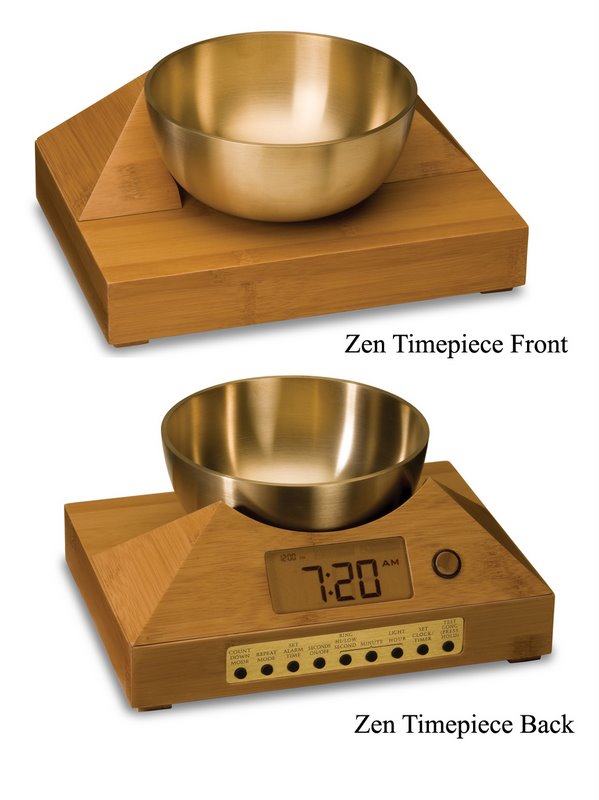 Zen Clocks will Peacefully Help You Awake Shop our Zen Clock Store
Now & Zen, Inc.
1638 Pearl Street
Boulder, CO 80302
(800) 779-6383
Posted in intention, Natural Awakening, sleep, Sleep Habits
|
|
|
|